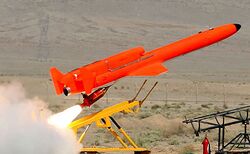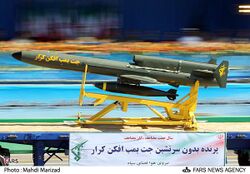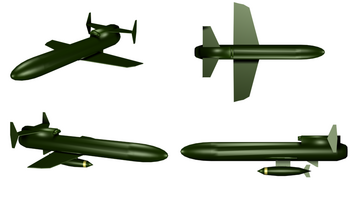Engineering:HESA Karrar
| HESA Karrar | |
|---|---|

| |
| Karrar UAV seen at the 8th International Iran Air Show on Kish Island in the Persian Gulf. | |
| Role | Unmanned aerial vehicle |
| National origin | Iran |
| Manufacturer | Iran Aircraft Manufacturing Industrial Company (HESA) |
| Introduction | 2010 |
| Status | In production[1] |
| Primary users | Iran Hezbollah |
| Produced | 2010 |
| Developed from | Beechcraft MQM-107 Streaker |
The HESA Karrar (Persian: کرار, "striker") is an Iranian jet-powered target drone manufactured by Iran Aircraft Manufacturing Industrial Company (HESA) since 2010. The Karrar is a derivative of the American 1970s-era Beechcraft MQM-107 Streaker target drone, probably incorporating elements from the South Africa n Skua, with hardpoints added for munitions. The Karrar was developed during the Ahmadinejad presidency.[2]
As a target drone, the Karrar is used to train air-defense crews by simulating an aerial target.[3] The Karrar is regularly spotted at Iranian air-defense drills, and is believed to be simply the replacement for Iran's aging American-built MQM-107 target drones.[4]
Design
The Karrar has a small, clipped delta wing mounted low to a cylindrical, blunt-nosed fuselage. It has a dorsal air intake for the engine and twin arrowhead-shaped endplate tailfins mounted high on the fuselage.[1]
The Karrar uses a rocket assist system to take off and is recovered by parachute.[1] It is also claimed to be capable of air launch.[1] Iranian officials have said the aircraft has surveillance capabilities, but the Karrar has no visible EO/IR sensors.[1] The Karrar is believed to have an autopilot system with INS and/or GPS guidance, and may have terrain following capability as well.[5] The Karrar is capable of both high and low altitude flight,[6] and of day and night flight.[7] It can follow a pre-programmed flight path, which can also be updated in flight.[7]
The Karrar can carry one 500 lb Mk 82 general-purpose bomb, with claimed precision guidance, on its centerline hardpoint. Alternatively, it can carry two Nasr-1 anti-ship missiles,[lower-alpha 1] two Kowsar anti-ship missiles, or two 250 pound Mk 81 general-purpose bombs on the underwing stations, or (since 2019) a Balaban satellite-guided glide bomb.[1][9][10] It is believed that carrying weapons substantially reduces the Karrar's operating range.[6]
Military experts quickly noted that Karrar bears an obvious resemblance to the US Beechcraft MQM-107 Streaker target drone designed in the 1970s and exported to Iran before the Iranian revolution. According to a report from Denel Dynamics, however, the Karrar is not an exact clone of the MQM-107 Streaker as some design elements have been copied from the Denel Dynamics Skua as well.[11] Technical data on the Skua was reportedly sold by one of the Skua's export customers to Iran.[1] Overall, the Karrar is not an exact copy of the MQM-107, and multiple design changes have been made.[6]
Operational history
Development of the Karrar was underway as of 2002, possibly under the name "Hadaf-1".[12] A subscale model of the Karrar was also seen around 2004. The Karrar is also known as the "Ababil Jet"; the Ababil is an unrelated UAV also offered by the same manufacturer, HESA.[7] Iran said the Karrar took "500,000 hours" to develop, but independent analysts say this is unlikely.[13]
The Karrar was unveiled on August 23, 2010, one day after the activation of a nuclear reactor in Bushehr, by Iranian president Mahmoud Ahmadinejad. It was framed as a "long-range bomber drone,"[14] and is the first long-range UAV manufactured in Iran.[15]
Multiple sources report that the Karrar has been exported to Hezbollah.[16][17] The Karrar has supposedly been used in the Syrian Civil War.[18]
In a 2011 article, Iranian military expert Galen Wright posited that the Karrar was not merely a target drone, but was mainly to be used as a sort of semi-disposable launch platform for an environment where Iran was unlikely to have air superiority.[5] Another article, from Defense Update, takes a similar view, and suggests in particular that the Karrar could be useful for using cruise missiles to target ground-based radars and naval ships.[6] In 2018, Daily Beast reporter Adam Rawnsley said that the Karrar, despite Iranian claims, does not possess the capacity to deploy weapons and is merely a target drone.[2]
Today, Karrar is regularly used by Iran's air defense force for training.[3][12] Karrar target drones have been used to test Mersad SAM systems,[19] S-300PMU-2 SAM systems,[20] Sayyad-2 SAM systems,[21] Fakour-90 air-to-air missiles,[22] and Sayyad-3 SAM systems.[23]
Operators
 Iran
Iran
- Islamic Republic of Iran Air Defense Force
Non-state user
- Hezbollah
Specifications
Data from Jane's All the World's Aircraft: Unmanned 2014-2015[1]
General characteristics
- Crew: none
- Capacity: 227 kg (500 lb) payload
- Length: 4 m (13 ft 1 in)
- Wingspan: 2.5 m (8 ft 2 in)
- Max takeoff weight: 700 kg (1,543 lb)
- Powerplant: 1 × Tolloue 5 or Microturbo TR 60-5 turbojet , 4.2–4.4 kN (940–990 lbf) thrust (est.)
Performance
- Maximum speed: 900 km/h (560 mph, 490 kn)
- Range: 1,000 km (620 mi, 540 nmi)
- Combat range: 500 km (310 mi, 270 nmi)
Armament
- Hardpoints: 3 with provisions to carry combinations of:
- Missiles:
2 × Kowsar
2 x Nasr-1 - Bombs:
1 × Mk 82 PGM on centerline
2 × 250 pound bomb
- Missiles:
See also
Aircraft of comparable role, configuration and era
- Galileo Mirach 150
- Tupolev Tu-300
- Alenia Aeronautica Sky-X
- WZ-2000
- Denel Dynamics Skua[1]
- ADE Lakshya[1]
References
- ↑ 1.0 1.1 1.2 1.3 1.4 1.5 1.6 1.7 1.8 1.9 Martin Streetly, ed (2014). Jane's All the World's Aircraft: Unmanned 2014-2015. London: IHS Jane's. pp. 80–81. ISBN 978-0710630964.
- ↑ 2.0 2.1 Adam Rawnsley [@arawnsley] (20 Jul 2018). "First off, Karrar is not a UCAV. Yes, yes, I know Iranian propaganda has billed it as a UCAV but it was rolled out during the Ahmadinejad era when lots of silly claims were made about Iran's drone capabilities.". https://twitter.com/arawnsley/status/1020420921448943616.
- ↑ 3.0 3.1 Adam Rawnsley [@arawnsley] (20 Jul 2012). "But Karrar vaporware. They just lied about what it's used for. If you were glancingly familiar with Iran's Air Defense Force, you'd recognize Karrar at air defense exercises". https://twitter.com/arawnsley/status/1020422169610924033.
- ↑ "Adam Rawnsley on Twitter". Twitter. 18 May 2018. https://twitter.com/arawnsley/status/997464811817652224.
- ↑ 5.0 5.1 Galen Wright (6 February 2011). "The Arkenstone - ارکنستون: Karrar UAV". https://web.archive.org/web/20110830185653/http://thearkenstone.blogspot.com/2011/02/karrar-uav.html.
- ↑ 6.0 6.1 6.2 6.3 "Karrar - Iran's New Jet-Powered Recce and Attack Drone". Defense Update. Aug 2010. https://web.archive.org/web/20120308044516/https://defense-update.com/products/k/karrar_jet_powered_drone_24082010.html.
- ↑ 7.0 7.1 7.2 Yuri Lyamin (21 July 2017). "Иранская экспозиция на МАКС-2017. Часть.2". https://imp-navigator.livejournal.com/638301.html.
- ↑ "Iran Unveils Domestically Produced Bomber Drone". Defense News. http://www.defensenews.com/story.php?i=4753618&c=MID&s=AIR. Retrieved 2010-08-23.
- ↑ Iran Unveils New Smart Bombs tasnimnews.com
- ↑ Iran holds unveiling event for precision guided bombs janes.com
- ↑ Keith Campbell. "New Iranian unmanned warplane not a SA copy, except, maybe, for the tailplane". Engineering News. http://www.engineeringnews.co.za/article/new-iranian-unmanned-warplane-not-a-copy-of-sa-design-except-maybe-for-the-tailplane-2010-09-10. Retrieved 2010-09-10.
- ↑ 12.0 12.1 Galen Wright (February 5, 2011). "Ababil UAV". http://thearkenstone.blogspot.com/2011/02/ababil-uav.html.
- ↑ Noah Shachtman (23 August 2010). "Iran's Robotic 'Ambassador of Death' is More Envoy of Annoyance (Updated)". Wired. https://www.wired.com/2010/08/irans-ambassador-of-death-drone-is-more-envoy-of-annoyance/.
- ↑ Vogelaar, Rob (August 22, 2010). "ran Unveils New Karar Bomber Drone". Aviation News. http://www.aviationnews.eu/2010/08/22/iran-unveils-new-karar-bomber-drone/.
- ↑ Daragahi, Borzou (August 23, 2010). "Iran Reveals its Own Drone". Sydney Morning Herald. http://www.smh.com.au/world/iran-reveals-its-own-drone-20100822-13ati.html. Retrieved August 23, 2010.
- ↑ "Israel Targets Hezbollah Weaponry in Syria". Dec 9, 2014. https://worldview.stratfor.com/article/israel-targets-hezbollah-weaponry-syria.
- ↑ Hassan Abbas (24 November 2010). "Is Lebanon's Hezbollah Equipped with New Iranian Drones?". Jamestown Foundation. https://jamestown.org/brief/briefs-128/.
- ↑ Mona Alami (9 February 2017). "Hezbollah's war in Aleppo: Victory at any cost, even to civilians". Middle East Eye. http://www.middleeasteye.net/news/hezbollahs-aleppo-victory-any-cost-1412427712.
- ↑ "Fars News Agency on Twitter". https://twitter.com/EnglishFars/status/462889268084342785.
- ↑ "Babak Taghvaee on Twitter". https://twitter.com/BabakTaghvaee/status/837328907363831808.
- ↑ "Babak Taghvaee on Twitter". https://twitter.com/BabakTaghvaee/status/814138938592030727.
- ↑ "Babak Taghvaee on Twitter". https://twitter.com/BabakTaghvaee/status/1021383601961750528.
- ↑ "Babak Taghvaee on Twitter". https://twitter.com/BabakTaghvaee/status/888711488382398464.
External links





